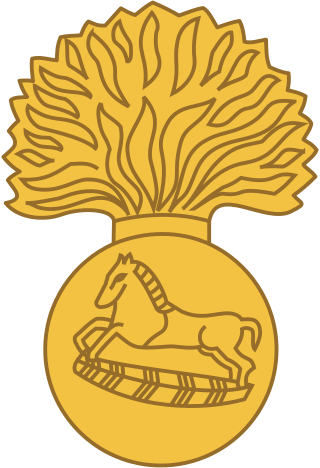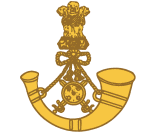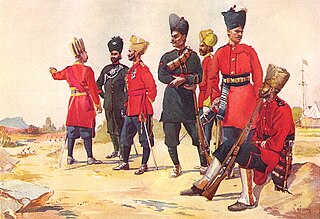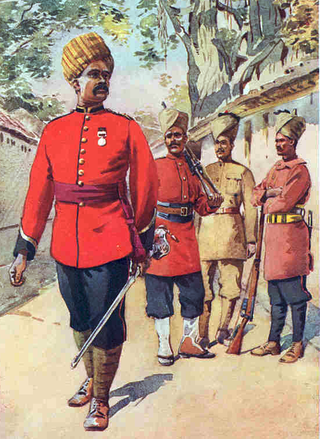The 101st Grenadiers was a regiment of the British Indian Army.

The Grenadiers is an infantry regiment of the Indian Army, formerly part of the Bombay Army and later the pre-independence British Indian Army, when the regiment was known as the 4th Bombay Grenadiers. It has distinguished itself during the two world wars and also since the Independence of India. The regiment has won many battle honours and gallantry awards, and is considered to be one of India's most decorated regiments with three Param Vir Chakra awardees in three different conflicts.

The Maratha Light Infantry is a light infantry regiment of the Indian Army. It traces its lineage to the Bombay Sepoys, raised in 1768, making it the most senior light infantry regiment in the Indian Army. The class composition of the regiment was and is primarily formed by Maratha recruits from the former Maratha Empire. The men are mostly drawn from all over the state of Maharashtra, with some percentage from Marathi-speaking areas of Karnataka including Coorg. The regimental centre has been in Belgaum, Karnataka, since 1922, which was part of the Bombay Presidency at that time. The battle cry of Maratha Light Infantry is, "Bola Shri Chhatrapati Shivaji Maharaj Ki Jai ". The regiment has won over 60 battle honours, including 21 in World War I.

The Bombay Army was the army of the Bombay Presidency, one of the three presidencies of British India.
The 108th Infantry were an infantry regiment of the British Indian Army. The regiment traces their origins to 1768, when they were raised as the 1st Battalion, Bombay Sepoys.

The 109th Infantry was an infantry regiment of the British Indian Army. The regiment traces its origins to 1768, when it was raised as the 5th Battalion, Bombay Sepoys.

The 104th Wellesley's Rifles were an infantry regiment of the British Indian Army. They could trace their origins to 1775, when they were raised as the 5th Battalion, Bombay Sepoys and presently its designation is 3 Guards of Indian Army.

The 91st Punjabis was an infantry regiment of the British Indian Army. The regiment was raised in 1800 as a battalion of Madras Native Infantry. It was designated as the 91st Punjabis in 1903 and became 3rd Battalion 8th Punjab Regiment in 1922. In 1947, it was allocated to Pakistan Army, where it continues to exist as 3rd Battalion of The Baloch Regiment.
The 64th Pioneers was a regiment of the British Indian Army. Originally serving as regular infantry it evolved into a specialist military pioneer unit performing engineering and construction tasks.

The 61st Pioneers were an infantry regiment of the British Indian Army. They trace their origins to1758, when they were raised as the 1st Battalion Coast Sepoys.

The 63rd Palamcottah Light Infantry was an infantry regiment of the British Indian Army. The regiment could trace its origins to 1759, when it was raised as the 4th Battalion Coast Sepoys.
The 69th Punjabis were an infantry regiment of the British Indian Army. They could trace their origins to 1759, when they were raised as the 10th Battalion Coast Sepoys.
The 72nd Punjabis were an infantry regiment of the British Indian Army. They could trace their origins to 1759, when they were raised as the 16th Battalion Coast Sepoys.
The 75th Carnatic Infantry were an infantry regiment of the British Indian Army. They could trace their origins to 1776, when they were raised as the 15th Carnatic Battalion by enlisting men from the 2nd, 6th and 12th Carnatic Battalions.

The 103rd Mahratta Light Infantry were an infantry regiment of the British Indian Army. They could trace their origins to 1768, when they were raised as the 2nd Battalion, Bombay Sepoys. The regiment was first in action in the Mysore Campaign during the Third Anglo-Mysore War, quickly followed by the Battle of Seedaseer and the Battle of Seringapatam in the Fourth Anglo-Mysore War. Their next action was at Beni Boo Ali against pirates in Eastern Arabia and the Persian Gulf region led the East India Company to carry out a punitive expedition in 1819 to Ras al Khaimah which destroyed the pirate base and removed the threat from the Persian Gulf.

The 107th Pioneers were an infantry regiment of the British Indian Army. Their origin can be traced back to 1788, when they were raised as the 4th Battalion, Bombay Sepoys.

The 110th Mahratta Light Infantry were an infantry regiment of the British Indian Army. The regiment traces their origins to 1797, when they were raised as the 2nd Battalion, 5th (Travancore) Regiment of Bombay Native Infantry.

The 114th Mahrattas were an infantry regiment of the British Indian Army. The regiment traces their origins to 1800, when they were raised as the 2nd Battalion, 7th Regiment of Bombay Native Infantry.

The 116th Mahrattas were an infantry regiment of the British Indian Army. The regiment traces their origins to 1800, when they were raised as the 2nd Battalion, 7th Regiment of Bombay Native Infantry.

The 117th Mahrattas were an infantry regiment of the British Indian Army. The regiment traces their origins to 1800, when they were raised as the Bombay Fencible Regiment.










